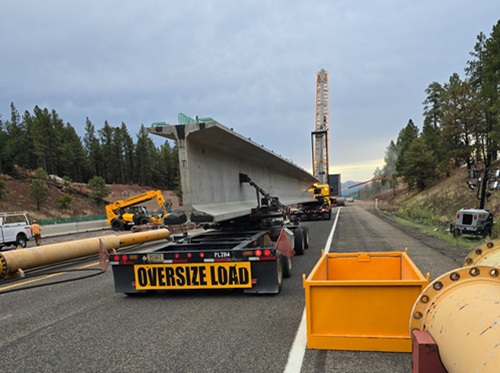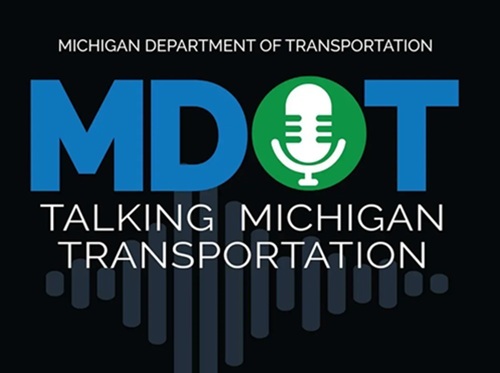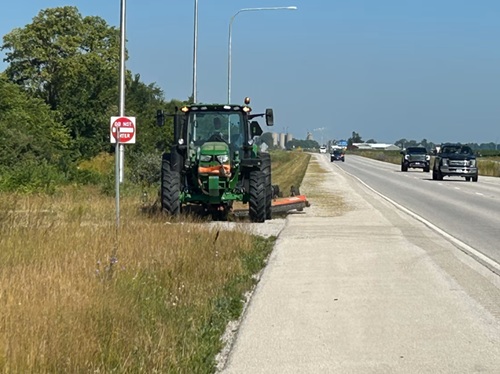Huge girders stretching across I-17 near Flagstaff, AZ, will soon support a safe elk and deer overpass through the forest and above motor vehicle traffic – all while protecting travelers from costly and dangerous collisions with wildlife.
[Above photo by Arizona DOT]
The Arizona Department of Transportation is scheduled to complete installation of the 26 girders for the Willard Springs Wildlife Overpass by the Labor Day weekend. The entire wildlife overpass is expected to be finished by fall of 2026.
Once all girders and the overpass deck is in place, crews will install native vegetation and landscape features to entice animals to use the bridge. Arizona DOT noted in a statement that it also will install or retrofit about 16 miles of wildlife fencing to funnel animals along the corridor to the overpass.
Arizona DOT and the Arizona Game and Fish Department developed the plans for the 100-foot-wide overpass after studying the I-17 interstate corridor – which passes through the Coconino National Forest, home to elk, deer, foxes, coyotes, bobcats, black bears, mountain lions, and smaller animals – to find the best place to build an animal-friendly crossing.
[Editor’s note: In the video below, produced by the New Mexico Department of Transportation, Chad Loberger with the Arizona Game and Fish Department, explains the role animal crossings play in the safety of wildlife and the traveling public.]
Arizona DOT said it applied for and received a grant from the Federal Highway Administration’s Wildlife Crossings Pilot Program to pay for the bulk of the $21 million overpass. The FHWA says more than a million wildlife vehicle collisions a year occur across the country, killing an average of 200 people and injuring 26,000 more.
Federal, state, and county officials identified “a hot spot for elk” along I-17 south of Flagstaff, noted Audrey Navarro – Arizona DOT’s biology program manager – on a recent episode of the “On the Road” podcast produced by the agency.
The hot spot overlapped with a stretch of the interstate that had no bridges and only one road culvert that elk and deer could use, she said, also stressing that the I-17 overpass is only the latest Arizona DOT project to prevent wildlife vehicle collisions. “We’ve been developing wildlife infrastructure for the past decade,” Navarro said on the podcast.
[Editor’s note: A recent episode of “The DOT POD” podcast produced by the New York State Department of Transportation also discussed how state DOTs are working to provide safer passage for wildlife across highways and roadways.]
Meanwhile, a 2021 Arizona DOT study reported that about 27 percent of all crashes in a 17-mile stretch of I-17 south of Flagstaff involved elk, mule deer, or black bear. The report concluded that a wildlife vehicle collision occurs at least twice a year along each mile of interstate. The agency added that vehicle wildlife collisions in Arizona killed four people and injured 241 people in 2023.
Other Arizona DOT wildlife projects include:
- Three wildlife overpasses and two underpasses for desert bighorn sheep along US 93 in far northwestern Arizona.
- Three wildlife underpasses on State Route 68 between Bullhead City and Golden Valley.
- Crossing and fencing on State Route 260 to reduce crashes with elk and deer.
- A six-mile reconstruction of State Route 77 north of Tucson that included an overpass and underpass connecting wildlife habitats in the Santa Catalina and Tortolita mountains.
- Two wildlife underpasses and six miles of fencing added to State Route 86 between Tucson and Sells.
Many state departments of transportation are working on ways to better protect animals and the motoring public through broad strategic efforts to identify key wildlife crossing areas and construct infrastructure to ensure safe animal passage.
For example, the Colorado Department of Transportation recently reached the 50 percent completion point for its I-25 Greenland Wildlife Overpass project located between Larkspur and Monument; what will be the world’s largest interstate-spanning bridge structure for wildlife once finished.
With the project reaching the halfway point, the structure to support the bridge has gone up, including foundation work of piers, columns, and the installation of 76 bridge girders; 38 over each direction of I-25. It is 200 feet wide and 209 feet long, covering 41,800 square feet or nearly an acre.
In October 2024, the California Department of Transportation issued a Wildlife Connectivity Report that identifies more than 140 locations where roadways can be better integrated with the migration needs of animals statewide.
The Utah Department of Transportation recently outlined its nearly five-decade effort to mitigate wildlife vehicle collisions statewide in an article in The Leaflet by AASHTO; a newsletter focused on state DOT environmental management issues published by the American Association of State Highway and Transportation Officials. That long-term effort by Utah DOT also included the recent development of The Utah Roadkill Reporter; a smartphone application introduced in 2022 that gets the public involved in reporting wildlife collisions.
And in November 2023, the Wyoming Department of Transportation completed wildlife crossings built as part of its $15.1 million Dry Piney project. The Dry Piney project – a joint effort between the Wyoming Game and Fish Department and the Wyoming DOT – includes nine underpasses and 16.7 miles of eight-foot-high fencing on both sides of Highway 189 in the western part of the state to protect big game animals, primarily mule deer.




